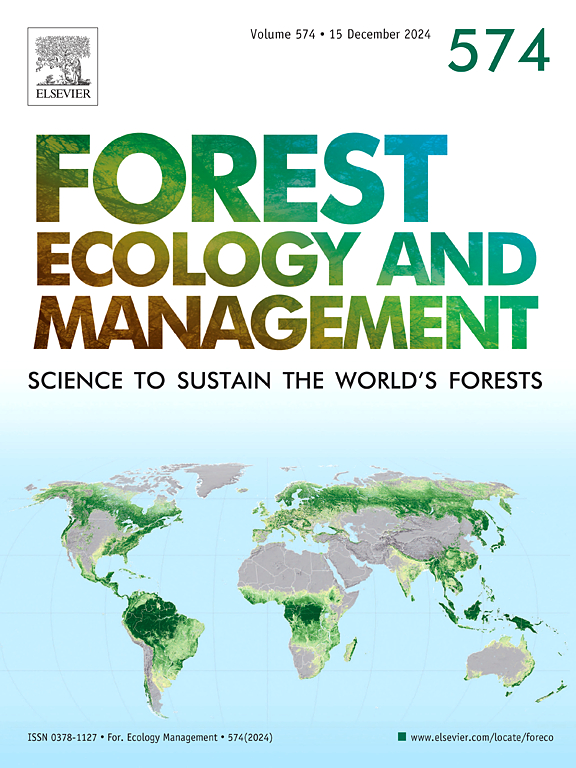Prediction of potential suitable areas and their trends for Picea worldwide under climate change
IF 3.7
2区 农林科学
Q1 FORESTRY
引用次数: 0
Abstract
Potentially suitable areas for Picea under climate change and the relationship with climate change were investigated to provide an introduction and foundation for conservation. By collecting extant distribution point data for 34 Picea species and 19 environmental variables from WorldClim, potentially suitable areas were simulated via the improved MaxEnt model during the modern period (1960–1990), and Last Interglacial (LIG), Last Glacial Maximum (LGM), Mid-Holocene (MH), future periods (2050s and 2070s) across two climate emission scenarios (RCP6.0 and RCP8.5). The MaxEnt model results exhibited high simulation accuracy, and the predicted suitable areas conformed with real growth and distribution patterns. The annual mean temperature (BIO17) and precipitation of the driest quarter (BIO01) were the primary climate factors influencing Picea dispersion. The total suitable area during the LIG period was 7.43 × 107km², which represents 93.34 % of the current total suitable area. The total suitable area during the LGM represents 76.31 % of the current total suitable area. The total suitable area during the MH represents 96.11 % of the current total suitable area. Under future climate scenarios, the total potentially suitable area exhibited a marginal increase of less than 3 %, while the highly suitable area experienced substantial reductions. Specifically, under RCP6.0, the highly suitable area decreased by 11.65 % and 13.60 % compared to current conditions. The most pronounced declines occurred under RCP8.5, with highly suitable area shrinking by 15.46 % and 20.41 % in the 2050 s and 2070 s, respectively, compared with that under the current scenario. Under future scenarios and among the 31 Picea species, the total suitable area for 22 species indicated a decreasing trend with the greatest decrease under the RCP8.5 scenario. Species with the largest total suitable areas were Picea obovata, Picea glauca, Picea mariana, and Picea abies, which all exceeded 1.00 × 106km². Under future climate scenarios, Picea abies showed an increasing trend, whereas the other three species exhibited decreasing trends. The total suitable areas for Picea breweriana and Picea morrisonicola were the smallest (less than 1.00 × 106km²), and they showed decreasing trends. The main climate factors influencing Picea distribution were BIO17 and BIO01 with precipitation impacting the distribution more than the temperature. The total suitable area for Picea first decreased and then increased from past to present. The total suitable area was smallest during the LGM. The total suitable area under future scenarios exceeded the current total suitable area, but the observed trend shows minimal significance with an increase of less than 3 %. The projected highly suitable area was smaller than the current extent. The highly suitable area declined the most under the RCP8.5 scenario. Picea generally migrated northeastwards and to higher latitudes. Species with a wide range of suitable areas, such as Picea neoveitchii, Picea omorika, and Picea jezoensis, which could exhibit larger future suitable areas, could be considered candidates for introduction and cultivation. For species with smaller total suitable areas, such as Picea breweriana, Picea morrisonicola, Picea chihuahuana, Picea alcoquiana, Picea torano, and Picea glehnii, which could exhibit smaller future suitable areas, monitoring and protection measures should be enhanced to ensure their survival under climate change.
气候变化下全球云杉潜在适宜生长区域及其趋势预测
研究了气候变化下云杉的潜在适宜生长区域及其与气候变化的关系,为云杉的保护提供了理论基础。利用改进的MaxEnt模型,利用WorldClim收集的34种云杉物种和19个环境变量的现有分布点数据,在现代期(1960—1990年)、末次间冰期(LIG)、末次盛冰期(LGM)、中全新世(MH)和未来期(2050年代和2070年代)两种气候排放情景(RCP6.0和RCP8.5)下,对潜在适宜区域进行了模拟。MaxEnt模型的模拟结果具有较高的精度,预测的适宜面积与实际生长和分布规律吻合。年平均气温(BIO17)和最干季降水(BIO01)是影响云杉扩散的主要气候因子。LIG时期的适宜总面积为7.43 × 107km²,占目前适宜总面积的93.34 %。LGM期间总适宜面积占当前总适宜面积的76.31 %。MH期间的总适宜面积占当前总适宜面积的96.11% %。在未来气候情景下,总潜在适宜面积的边际增幅小于3 %,而高度适宜面积则大幅减少。其中,在RCP6.0条件下,高度适宜面积比当前条件分别减少了11.65 %和13.60 %。RCP8.5情景下下降最为明显,2050年 s和2070年 s高度适宜面积分别比当前情景减少15.46 %和20.41 %。在未来情景下,31种云杉树种中有22种的总适宜面积呈减少趋势,其中RCP8.5情景下减少幅度最大。总适宜面积最大的树种为双峰云杉(Picea obovata)、青云杉(Picea glauca)、mariana云杉(Picea mariana)和冷杉(Picea abies),均超过1.00 × 106km²。在未来气候情景下,云杉的生物量呈增加趋势,其他3种均呈减少趋势。啤酒云杉(Picea breweriana)和云杉(Picea morrisonicola)的适宜总面积最小(小于1.00 × 106km²),且呈减少趋势。影响云杉分布的主要气候因子是BIO17和BIO01,其中降水对云杉分布的影响大于温度。从过去到现在,云杉总适宜面积先减小后增大。在LGM期间,总适宜面积最小。未来情景下的总适宜面积超过了当前的总适宜面积,但观测到的趋势不显著,增幅小于3 %。预测的高度适宜面积小于目前的范围。RCP8.5情景下高度适宜面积降幅最大。云杉一般向东北和高纬度地区迁移。适宜区范围较广的新云杉(Picea neveitchii)、云杉(Picea omorika)、云杉(Picea jezoensis)等未来适宜区面积较大的树种可作为引种栽培的备选种。对于总适宜区较小的品种,如啤酒云杉(Picea breweriana)、morrisonicola云杉(Picea morrisonicola)、吉华云杉(Picea chihuahuana)、alcoquiana云杉、torano云杉(Picea torano)、glehnii云杉(Picea glehnii),未来适宜区可能较小,应加强监测和保护措施,确保其在气候变化下的生存。
本文章由计算机程序翻译,如有差异,请以英文原文为准。
求助全文
约1分钟内获得全文
求助全文
来源期刊

Forest Ecology and Management
农林科学-林学
CiteScore
7.50
自引率
10.80%
发文量
665
审稿时长
39 days
期刊介绍:
Forest Ecology and Management publishes scientific articles linking forest ecology with forest management, focusing on the application of biological, ecological and social knowledge to the management and conservation of plantations and natural forests. The scope of the journal includes all forest ecosystems of the world.
A peer-review process ensures the quality and international interest of the manuscripts accepted for publication. The journal encourages communication between scientists in disparate fields who share a common interest in ecology and forest management, bridging the gap between research workers and forest managers.
We encourage submission of papers that will have the strongest interest and value to the Journal''s international readership. Some key features of papers with strong interest include:
1. Clear connections between the ecology and management of forests;
2. Novel ideas or approaches to important challenges in forest ecology and management;
3. Studies that address a population of interest beyond the scale of single research sites, Three key points in the design of forest experiments, Forest Ecology and Management 255 (2008) 2022-2023);
4. Review Articles on timely, important topics. Authors are welcome to contact one of the editors to discuss the suitability of a potential review manuscript.
The Journal encourages proposals for special issues examining important areas of forest ecology and management. Potential guest editors should contact any of the Editors to begin discussions about topics, potential papers, and other details.
 求助内容:
求助内容: 应助结果提醒方式:
应助结果提醒方式:


